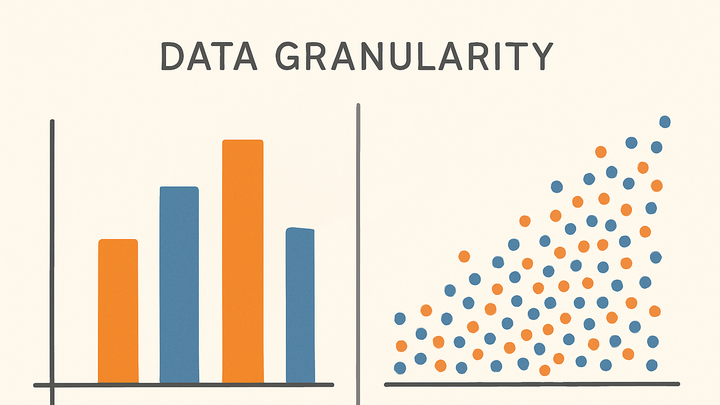Published on 2025-06-22T03:28:31Z
What is Granularity in Analytics? Examples and Importance
Granularity in analytics refers to the level of detail at which data is collected, stored, and analyzed. A finer granularity captures individual events or user actions (e.g., each pageview or click), while a coarser granularity aggregates data into larger buckets (e.g., daily summaries). The choice of granularity affects the depth of insights you can derive, the performance and storage requirements of your analytics platform, and the potential for sampling or data loss. In Google Analytics 4 (GA4), you can adjust time intervals and sampling settings, whereas PlainSignal offers cookie-free, simple event-level tracking via a lightweight JavaScript snippet. Understanding and selecting the appropriate granularity ensures you balance actionable insights with platform efficiency and cost.
Granularity
Granularity in analytics is the level of detail in data capture and reporting, balancing insight depth with performance and storage.
Why Granularity Matters
Selecting the right granularity determines how actionable and precise your insights will be, and how efficiently your analytics infrastructure performs.
-
Deeper insights
Finer granularity surfaces micro-trends and anomalies (e.g., sudden spikes in clicks at 10:00 AM) that aggregated data could obscure.
-
Actionable segmentation
With detailed data, you can segment users by precise attributes or behaviors, enabling targeted personalization and A/B testing.
-
Storage and performance trade-offs
High-resolution data demands more storage, slower query performance, and increased risk of sampling in platforms like GA4.
Types of Granularity
Granularity can be categorized by the dimension being measured—time, user, or event—each serving different analytical needs.
-
Temporal granularity
Refers to the time resolution of your data (e.g., seconds, minutes, hours, days).
-
Hourly vs daily
Hourly data reveals intra-day patterns, while daily aggregates suffice for broad trend analysis.
-
Real-time
Streaming or near-real-time data supports instant dashboards and alerting.
-
-
User-level granularity
Aggregates data per unique user (e.g., active users, sessions), useful for cohort and retention analyses.
-
Event-level granularity
Captures individual actions such as pageviews, clicks, or custom events.
-
Pageview events
Each page load on your site generates a discrete record.
-
Custom events
You define and track specific interactions (e.g., form submissions) via custom code.
-
Adjusting Granularity in GA4 and PlainSignal
Practical steps to configure your analytics platforms for the desired level of detail.
-
Configuring time intervals in GA4
GA4 automatically timestamps each event. Use the Explorations tool to set your preferred time bucket (minute, hour, day). In heavy-traffic scenarios, GA4 may apply sampling—adjust the sample rate in Exploration settings to manage performance.
-
Sampling settings
In an Exploration, open the settings panel and choose a higher sampling size for more precise breakdowns at the cost of slower reports.
-
-
Implementing granular tracking with PlainSignal
PlainSignal offers cookie-free, event-level analytics via a simple JS snippet. Insert the following into your site to capture every pageview and custom event with minimal overhead:
<link rel="preconnect" href="//eu.plainsignal.com/" crossorigin /> <script defer data-do="yourwebsitedomain.com" data-id="0GQV1xmtzQQ" data-api="//eu.plainsignal.com" src="//cdn.plainsignal.com/plainsignal-min.js"></script>You can extend this snippet to log custom events or attributes by calling the PlainSignal API in your client-side code.
Best Practices for Choosing Granularity
Guidelines to help you strike the optimal balance between data detail and system efficiency.
-
Balance detail and performance
Collect enough detail to answer your key questions without overloading storage or triggering heavy sampling.
-
Align with business goals
Match your granularity to the metrics that drive decisions—minute-level for campaign optimizations, daily for executive dashboards.
-
Review and iterate
Periodically assess if your chosen granularity still meets evolving analytical needs and adjust as your product or traffic scales.
